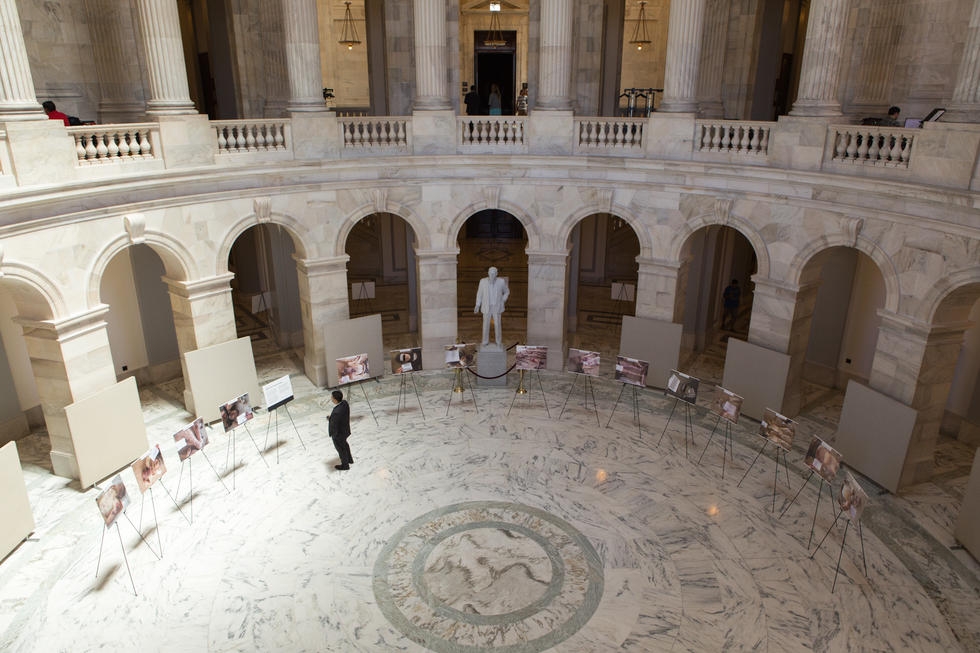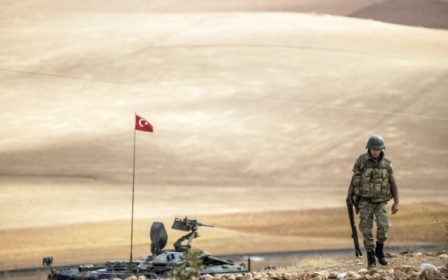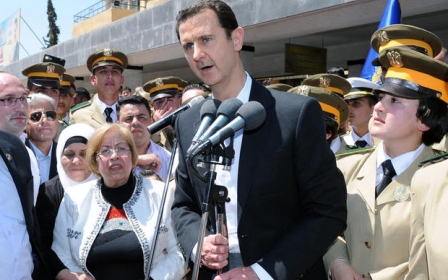Syria photo exhibition focuses on US Congress

Washington, DC - Horrific images that defy the imagination, of dead Syrians whose bodies appear to be scarred by various methods of torture: starvation, amputations, scorching.
On Capitol Hill, visitors saw these gruesome photos, allegedly taken between 2011 and 2013 in two military hospitals near the Syrian capital of Damascus, on orders of the government's intelligence service.
Smuggled to the US by a Syrian army defector, the pictures were put on display at the heart of the nation's capital, as critics of the Obama administration accuse it of not doing enough to stop the bloodshed in the Middle Eastern country.
Code-named "Caesar", the former Syrian military police photographer, whose identity remains a mystery, testified before Congress last summer, after having brought to light a trove of 55,000 pictures taken by himself and roughly a dozen other photographers who worked for the security apparatus.
The photos are purportedly part of an archive used by the state to catalogue deaths, thus proving to higher-ups that executions of political opponents were carried out, and also to produce death certificates for next-of-kin.
While the Syrian government has dismissed the photos as forgeries, the FBI, human rights experts and the group behind the exhibit – also known as "the Caesar Team" – say they are authentic.
The exhibition has already been held at the UN headquarters in New York, and samples were shown at the European Parliament in Belgium, reversing an earlier decision that had led to accusations of censorship by critics. An European parliament group tasked with such matters had initially decided against displaying the gruesome images after deeming them too “offensive and disturbing”.
Following a showing by the US Holocaust Memorial Museum in Washington DC, a small fraction was put on display for congressmen in the Rayburn House building foyer and at the Senate's Russell building rotunda.
Mouaz Mustafa, a member of the Caesar Team, said he wanted to ensure that the exhibit was displayed in a “bipartisan” fashion – to expose everyone at the Capitol, including “some Democrats who don't criticise the president,” to “the genocidal massacres in Syria”.
“The UN has proved impotent on Syria, so we thought the US Capitol would be a perfect place to hold the exhibit, especially because we had also given up on the administration doing anything on Syria,” he said.
“Even on the Hill, I can tell you that there are members who are well-versed on Syria, but were taken aback by the pictures,” said Mustafa, who runs the Syrian Emergency Task Force, and "United for a Free Syria" – political advocacy and humanitarian groups.
In recent years, anger in the US has accelerated over the Obama administration's apparent lack of a coherent strategy in Syria. An American former diplomat, who attended the exhibition, said the US had a “moral” and “strategic” duty to do more on Syria.
“This is something that the administration needs to deal with and there's an urgency there,” said James Hooper, managing director of the Public International Law and Policy Group, a non-profit legal organisation. “It's not just about making those responsible accountable; the priority is to prevent more torture from taking place.”
Survivors of torture said they were vindicated by the public release of the photographs.
“It took them five hours of beating me to get tired before carrying me to my cell,” said Qutaiba Idlbi, a former detainee in Syria, who said he was questioned and tortured twice in Syria before he escaped to the US. Idlbi said he managed to identify at least two people from the images: a neighbour and a doctor.
The exhibition comes at a time when many are debating the US's policy toward Syria. Some members of Congress are pushing for the establishment of protected zones for civilians, as well as support and aid to Syrian rebel groups. There have also been calls for the creation of no-fly zones.
Attending the exhibition, Senator John McCain, who has been at the forefront of opposition to the administration's handling of the Syrian conflict, said the decision to restrict US aid to Syrian opposition fighters was wrong.
“We're training people, and plans are to train many more, send them into Syria to fight only ISIS and not even vow to protect them against [Syrian president] Bashar Assad's barrel-bombing,” said McCain. “That, my friends, is a shameful, shameful policy.”
The US has so far invested $500mn in Syrian training programmes, but the resulting number of recruits has been negligible: 60. In four year, Syria’s civil war has claimed more than 220,000 lives and displaced about 11 million people – more than 7 million internally.
Some believed the purpose of the display was to push for a military intervention in Syria.
“These pictures are put there not to educate people – no one is doubting that the regime is a brutal one; that's a given,” said Phyllis Bennis, director of the New Internationalism Project at the Institute for Policy Studies in Washington DC.
“They are there to raise everyone's emotional attention and get people agitated enough so they will get the US, to do “something,” and that “something” is almost always defined as military [in nature]. This is an advocacy goal to escalate military involvement.”
Bennis said an entirely different approach is needed in Syria.
“What's needed is ... far more energy, time, money, high-level attention, political pressure invested in the interest of real diplomacy,” she said. “Putting all the energy now going into military forces into restarting broad talks with Russia and Iran about Syria and Iraq. There also needs to be an arms embargo on all sides.”
New MEE newsletter: Jerusalem Dispatch
Sign up to get the latest insights and analysis on Israel-Palestine, alongside Turkey Unpacked and other MEE newsletters
Middle East Eye delivers independent and unrivalled coverage and analysis of the Middle East, North Africa and beyond. To learn more about republishing this content and the associated fees, please fill out this form. More about MEE can be found here.




